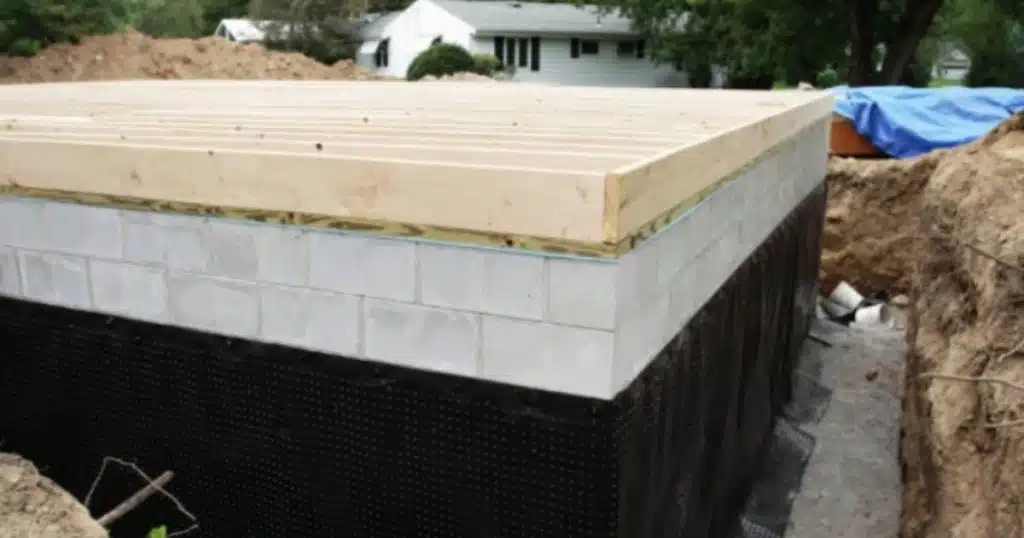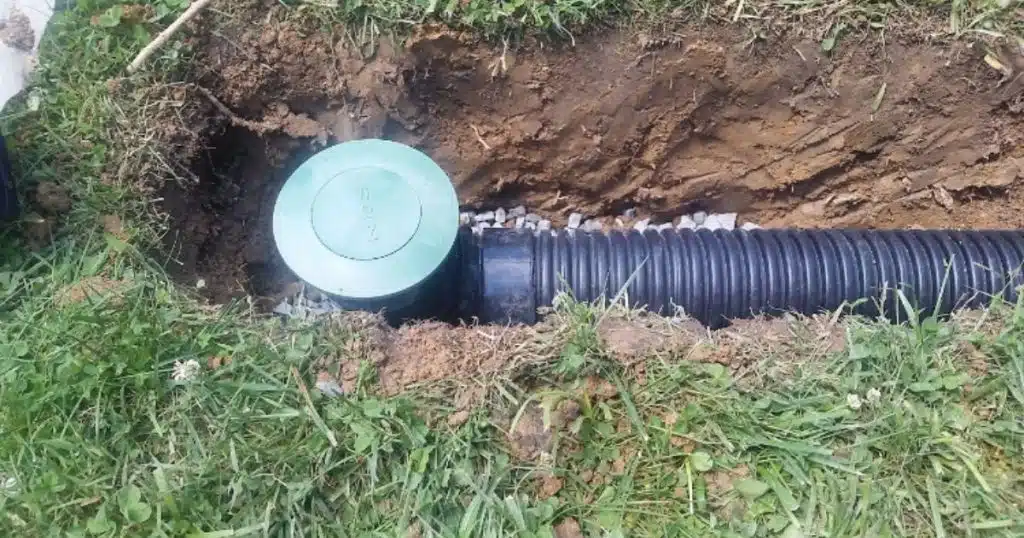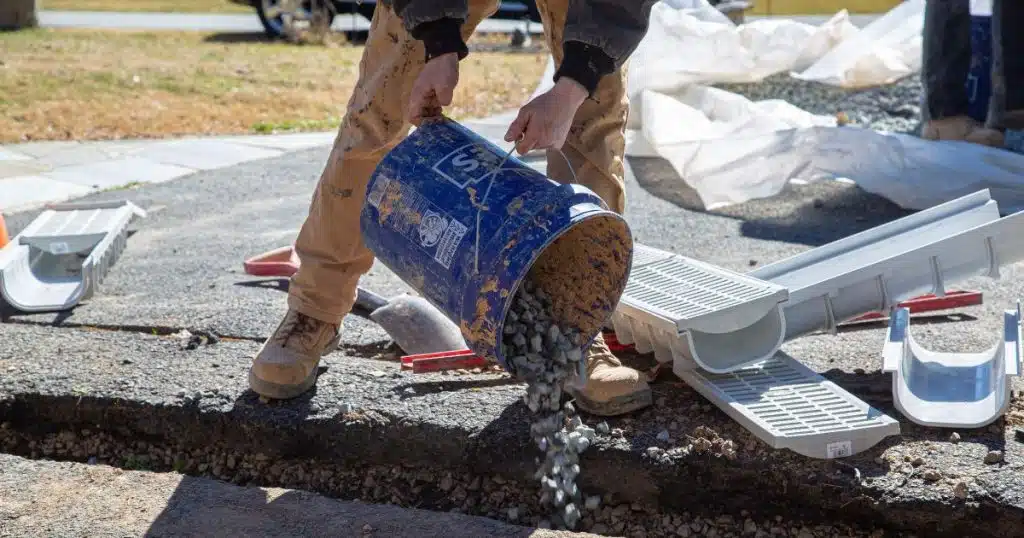A basement is a valuable space in your home, serving various purposes, from storage to extra living space to recreational areas. However, basements are prone to moisture intrusion, leading to costly repairs and health risks.
Basement waterproofing is essential for maintaining your home’s integrity, as it protects your foundation from water damage and protects your belongings from dampness and mold. A pivotal aspect of basement waterproofing is the implementation of drainage systems, which help keep your living space dry by channeling water away from your home’s foundation.
This article will explore the drainage solutions for basement waterproofing and how they can keep your living space dry and protected.
Understanding Drainage Systems

Before diving into the specifics of drainage systems, it’s crucial to understand their importance in basement waterproofing. An effective basement drainage system is the key to preventing moisture damage by redirecting water away from the foundation. It ensures that it does not accumulate around the basement wall, reducing the risk of leaks, mold growth, and structural issues. Two main types of drainage systems are commonly used: interior and exterior.
Interior Drainage System

Interior drainage systems are installed within the basement and are designed to manage water that enters from the interior or seeps through the foundation walls. These systems have several benefits, including their ability to handle high volumes of water and manage hydrostatic pressure.
It involves the use of sump pumps and French drains. A sump pump is a device that collects water from the system and pumps it away from the foundation. French drains, on the other hand, are perforated pipes installed around the perimeter of the foundation to redirect water toward the sump pump.
Combining a sump pump and French drains has various benefits to effectively prevent moisture from pooling in the foundation, ensuring a dry and protected environment.
The installation process of interior drainage systems:
- It begins with excavating a perimeter trench along the basement walls. This trench is lined with a membrane to prevent further moisture intrusion.
- Next, a layer of gravel is added to the bottom of the trench to facilitate proper drainage. The perforated pipes, such as the French drain, are placed on the gravel and connected to the sump pump.
- Finally, the trench is backfilled, and the system is ready to manage any water that enters the living space effectively.
This comprehensive approach ensures that any water source is efficiently drained, reducing the risk of damage. Additionally, these systems are relatively easy to maintain. Regular checks of the sump pump, ensuring it is working properly and is free of debris, and clearing any clogs in the French drains are essential for optimal performance.
Exterior Drainage System

While the interior drainage system manages water that has already entered the basement, the exterior drainage system focuses on catching excess water and preventing it from reaching the foundation walls in the first place. These systems are designed to control surface water runoff and direct it away from the house, protecting your basement floor and foundation from hydrostatic pressure.
Proper grading and slope are crucial aspects of an effective exterior drain system. The surrounding landscape should be graded to encourage water to flow away from the foundation.
Ideally, the slope should be at least one inch for every twelve feet. This ensures that water naturally drains away from the basement walls, minimizing the risk of moisture seepage.

Another important component of this system is the use of downspout extensions. Downspouts are responsible for carrying water from the gutters to the ground. By extending the downspouts away from the foundation, water is directed farther from the basement walls, reducing the chances of infiltration.
Regular gutter maintenance is an essential aspect, as clogged gutters can lead to overflow and foundation damage.
Choosing the Right Drainage System

Several factors should be considered when selecting a drain system for your basement.
It is highly recommended to consult with a professional waterproofing contractor or to assess your basement’s specific needs. These experts can accurately evaluate the severity of the water issues and guide you in choosing a basement waterproofing method tailored to your situation.
- the extent of moisture issues,
- the specific characteristics,
- and your budget will all play a role in determining the most suitable solution.
Professional advice ensures that you make an informed decision and invest in a solution that provides long-term protection for your living space.
Both interior and exterior drainage systems have advantages in preventing water damage to your property, and their choice depends on various factors. An interior system with sump pumps may be more effective for foundations with chronic moisture problems or high water tables.
On the other hand, an exterior system is ideal for managing surface water and preventing it from reaching the foundation walls. It is ideally installed during the building process of a new construction home.
Maintenance and Upkeep
Regular maintenance is essential to ensure the excellent performance of your basement drainage system. Neglecting maintenance can lead to clogged pipes, pump failures, or improper water diversion.
Here are some guidelines for maintaining your drainage system:
- Inspect and clean your sump pump, and French drains regularly.
- Check for any signs of wear, test the pump to ensure it functions correctly, and clean out any debris that may accumulate in the sump pit.
- Ensure that the downspout extensions are securely in place and that your exterior grading and slope effectively divert water away from the foundation.
- Check and clean gutters and downspout extensions regularly.
Watch for any signs of water seepage or moisture on the basement walls, as they could indicate a problem with the system.
It’s important to address any signs of system issues promptly. Some common signs include:
- basement flooding
- standing water
- musty basement smell
- mold and mildew growth
- leaks
- wood rot
- peeling paint or drywall
- foundation cracks in the walls or floor
If you notice any of these warning signs, it is important to take action as soon as possible. Ignoring the problem can lead to further damage and potential structural issues. By diligently maintaining, you can identify potential problems and address them promptly, ensuring your living space remains dry and protected.
Get the Ultimate Drainage Solution for Guaranteed Basement Waterproofing
Effective drainage solutions are vital for waterproofing the basement. It can help keep your living space dry and protected from moisture damage by having properly installed and maintained drainage systems—both inside and outside your home.
To achieve long-term success, it’s essential to consult professionals at Lux Foundation Solutions to assess and give you a solution tailored to your basement’s specific needs.
Don’t wait for water damage to occur before taking proactive measures to protect your basement. Taking preventative action by waterproofing your basement today will provide numerous benefits for years to come. Contact Lux Foundation Solutions today to schedule a free estimate and learn more about how our innovative basement waterproofing system keeps your living space dry and protected.
Frequently Asked Questions
Can I install a drainage system in my basement myself?
It is recommended to consult with professionals as they have the expertise and experience to assess your specific situation and provide the most effective solution.
How much does it cost to install a basement drainage system?
The cost can vary depending on factors such as the size of your living space, the severity of the issues, and the chosen method. Consulting with professionals will provide you with an accurate cost estimate based on your specific requirements.
Are interior drainage systems noisy?
Modern interior drainage systems, including sump pumps, are designed to operate quietly. With proper installation and maintenance, you should not experience significant noise disturbances.
Do I still need a drainage system if I don’t have visible water issues in my basement?
Even if you don’t currently have visible moisture issues, it’s still important to consider it for preventive measures. Moisture damage can occur continuously over time, and investing in it can help to maintain a healthy basement and mitigate potential risks in the future.
How often should I maintain my basement drainage system?
Regular maintenance is essential to ensure effective performance. Inspecting and cleaning the system at least once a year, or more frequently if you notice any signs of issues, is recommended.
